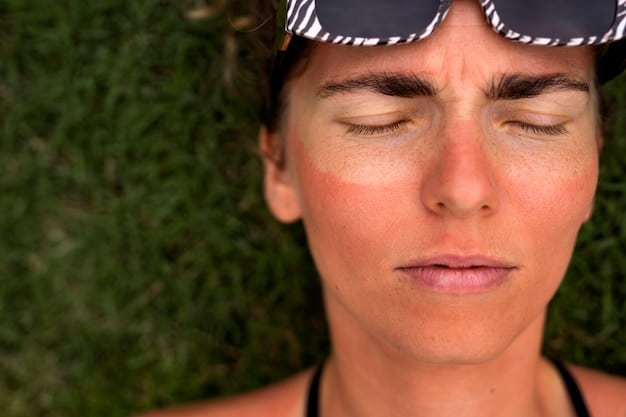Adapt Your Skincare for 2025: UV Index Increase Guide

Adapting your skincare routine for 2025 involves prioritizing increased sun protection due to a projected 15% rise in the UV index, necessitating higher SPF, antioxidant-rich products, and protective habits like seeking shade.
As we approach 2025, projections indicate a significant increase in the UV index, meaning stronger and more damaging sun rays. It’s crucial to understand how to adapt your skincare routine for 2025’s projected 15% increase in UV Index to protect your skin effectively.
Understanding the Projected UV Increase in 2025
The anticipated rise in the UV index isn’t just a minor inconvenience; it’s a serious concern for skin health. This increase means that the sun’s harmful rays will be more intense, potentially leading to quicker sunburns, accelerated aging, and a higher risk of skin cancer. Understanding the causes and implications of this increase is the first step in protecting yourself.
Factors Contributing to the UV Increase
Several environmental factors contribute to the projected rise in the UV index. Here are a few key aspects:
- Ozone Depletion: Continued thinning of the ozone layer allows more UV radiation to reach the Earth’s surface.
- Climate Change: Changes in atmospheric conditions and cloud cover can affect UV radiation levels.
- Geographical Location: Areas closer to the equator or at higher altitudes are naturally exposed to higher UV levels.
The Impact on Your Skin
The intensified UV radiation can have numerous adverse effects on your skin. These effects range from immediate concerns like sunburn to long-term damage such as premature aging and increased skin cancer risk.
- Sunburn: Higher UV levels mean you’ll burn faster and more severely.
- Premature Aging: Prolonged exposure to intense UV rays accelerates the breakdown of collagen and elastin, leading to wrinkles and sagging skin.
- Increased Risk of Skin Cancer: UV radiation is a major risk factor for all types of skin cancer, including melanoma.
By understanding these factors and their impact, you can better appreciate the need to adapt your skincare routine. Prevention and protection are key to maintaining healthy skin in the face of increasing UV exposure.

Boosting Sun Protection: Sunscreen Essentials for 2025
With the UV index set to increase, your approach to sunscreen must evolve. It’s no longer enough to simply apply sunscreen occasionally. You need to choose the right product, apply it correctly, and reapply frequently to ensure optimal protection. This section covers the essential aspects of sunscreen use for 2025.
Choosing the Right Sunscreen
Selecting the right sunscreen is the first line of defense against increased UV radiation. Here are the key factors to consider:
- SPF Level: Opt for a broad-spectrum sunscreen with an SPF of 30 or higher. This will block 97% of UVB rays.
- Broad Spectrum: Ensure your sunscreen protects against both UVA and UVB rays. UVA rays contribute to aging, while UVB rays cause sunburn.
- Water Resistance: Choose a water-resistant formula, especially if you’ll be sweating or swimming. Also, remember to reapply every two hours.
Proper Application Techniques
Even the best sunscreen won’t work if it’s not applied correctly. Follow these guidelines to ensure adequate coverage:
- Apply Generously: Use about one ounce (two tablespoons) of sunscreen to cover your entire body.
- Apply Early: Apply sunscreen 15-30 minutes before sun exposure to allow it to bind to your skin.
- Don’t Forget Often-Missed Spots: Cover your ears, neck, feet, and the back of your hands.
Reapplication is Key
Sunscreen needs to be reapplied every two hours, or immediately after swimming or sweating. Set reminders and carry a travel-sized sunscreen with you to make reapplication easier.
By adopting these sunscreen essentials, you’ll be better prepared to face the increased UV radiation in 2025. Consistent and correct sunscreen use is vital for protecting your skin and maintaining its health.
Antioxidants: Your Skin’s Best Friend Against UV Damage
While sunscreen is essential, it’s not the only tool in your arsenal. Antioxidants play a crucial role in protecting your skin from UV damage by neutralizing free radicals. Integrating antioxidant-rich products into your skincare routine can enhance your skin’s resilience and overall health.
Understanding Antioxidants and Free Radicals
UV radiation generates free radicals in the skin, which can damage cells and accelerate aging. Antioxidants combat this process by neutralizing these free radicals, preventing them from causing harm.
Topical Antioxidants for Daily Use
Incorporating topical antioxidants into your daily skincare routine can significantly boost your skin’s defense against UV damage. Some of the most effective antioxidants include:
- Vitamin C: Brightens skin, boosts collagen production, and provides antioxidant protection.
- Vitamin E: Moisturizes skin and protects against free radical damage.
- Niacinamide: Reduces inflammation, improves skin tone, and strengthens the skin barrier.
Antioxidant-Rich Diet
Complementing your topical skincare with an antioxidant-rich diet can further enhance your skin’s protection. Foods high in antioxidants include:
- Berries: Rich in vitamins and antioxidants.
- Leafy Greens: Packed with nutrients and antioxidants.
- Nuts and Seeds: Provide healthy fats and antioxidants.
By combining topical antioxidants with a healthy diet, you can create a comprehensive defense against UV damage, keeping your skin healthy and radiant. Antioxidants are an essential component of any skincare routine aimed at combating the effects of increased UV radiation.
Protective Clothing and Accessories: Shielding Your Skin Beyond Skincare
Skincare isn’t just about creams and serums; it’s also about what you wear. Protective clothing and accessories can provide an additional layer of defense against the sun’s harmful rays. Integrating these items into your everyday wardrobe can significantly reduce your skin’s exposure to UV radiation.
The Importance of Protective Clothing
Clothing acts as a physical barrier against the sun. However, not all fabrics are created equal. Here’s what to look for in protective clothing:
- UPF Rating: Choose clothing with an Ultraviolet Protection Factor (UPF) rating of 30 or higher.
- Fabric Type: Tightly woven fabrics like denim, nylon, and polyester offer better protection than loosely woven materials.
- Color: Darker colors absorb more UV rays than lighter colors.
Essential Accessories for Sun Protection
In addition to clothing, certain accessories can provide additional protection for areas often exposed to the sun. These include:
- Wide-Brimmed Hats: Protect your face, ears, and neck from the sun.
- UV-Protective Sunglasses: Shield your eyes and the delicate skin around them.
- Gloves: Protect your hands, especially while driving or engaging in outdoor activities.

Integrating Protective Measures into Your Daily Life
Making protective clothing and accessories a part of your daily routine is crucial for long-term skin health. Whether you’re running errands or spending time outdoors, these simple additions can make a significant difference.
By incorporating protective clothing and accessories into your lifestyle, you can create a comprehensive shield against the increased UV radiation in 2025. These measures, combined with a robust skincare routine, ensure your skin stays healthy and protected.
Seeking Shade: Strategic Sun Avoidance for Optimal Skin Health
One of the simplest and most effective ways to protect your skin is by seeking shade, especially during peak UV hours. Strategic sun avoidance can significantly reduce your exposure to harmful radiation and minimize the risk of skin damage. This section explores how to make shade-seeking a part of your daily routine.
Understanding Peak UV Hours
The sun’s rays are most intense between 10 a.m. and 4 p.m. During these peak UV hours, it’s essential to take extra precautions to protect your skin. Avoid prolonged sun exposure and seek shade whenever possible.
Creating Shade Opportunities
Whether you’re at home or on the go, there are numerous ways to create shade and reduce your exposure to UV radiation. Consider these options:
- Use Umbrellas: Carry a portable umbrella for shade on sunny days.
- Seek Natural Shade: Utilize trees, buildings, and other structures to find shade.
- Plan Activities: Schedule outdoor activities for early morning or late afternoon when UV levels are lower.
Making Shade-Seeking a Habit
Integrating shade-seeking into your daily routine requires conscious effort. Here are some tips to make it a habit:
- Monitor UV Levels: Use a UV index app to track radiation levels and plan accordingly.
- Set Reminders: Use your phone or watch to remind you to seek shade during peak hours.
- Educate Others: Encourage family and friends to join you in practicing sun-safe behaviors.
By prioritizing shade-seeking, you can significantly reduce your skin’s exposure to harmful UV radiation. This simple yet effective strategy is a crucial component of a comprehensive skincare routine for 2025.
Hydration and Skin Health: Maintaining Moisture in Increased UV Conditions
Hydration is vital for maintaining healthy skin, especially as UV radiation increases. Adequate hydration helps your skin function properly, repair itself, and resist damage from the sun. This section explores the importance of hydration and how to ensure your skin stays moisturized in 2025.
The Role of Hydration in Skin Health
Proper hydration supports the skin’s natural barrier function, which protects against environmental stressors like UV radiation. Dehydrated skin is more vulnerable to damage and slower to heal.
Internal Hydration: Drinking Enough Water
Drinking enough water is essential for maintaining skin hydration. Aim to drink at least eight glasses of water per day, and increase your intake during hot weather or after exercise.
External Hydration: Moisturizers and Emollients
In addition to drinking water, using moisturizers and emollients can help hydrate your skin from the outside. Look for products that contain:
- Hyaluronic Acid: Attracts and retains moisture in the skin.
- Glycerin: A humectant that draws moisture from the air into the skin.
- Ceramides: Help restore the skin’s natural barrier function.
Adjusting Your Routine for Increased UV
As UV radiation increases, you may need to adjust your hydration routine to compensate for moisture loss. Consider these tips:
- Use a Heavier Moisturizer: Switch to a richer, more hydrating formula, especially at night.
- Apply Moisturizer After Showering: Lock in moisture by applying moisturizer while your skin is still damp.
- Avoid Harsh Cleansers: Use gentle, hydrating cleansers that won’t strip your skin of its natural oils.
By prioritizing hydration, you can help your skin stay healthy, resilient, and protected against the increased UV radiation in 2025. Hydration is a fundamental aspect of any comprehensive skincare routine.
| Key Point | Brief Description |
|---|---|
| ☀️ High SPF | Use broad-spectrum SPF 30+ sunscreen daily. |
| 🛡️ Antioxidants | Incorporate Vitamin C, E, and niacinamide. |
| 👒 Protective Gear | Wear hats, sunglasses, and UPF clothing. |
| 💧 Hydration | Stay hydrated and moisturize regularly. |
FAQ
Aim for a broad-spectrum sunscreen with an SPF of 30 or higher to block at least 97% of UVB rays. Reapply every two hours, especially after swimming or sweating, to maintain protection.
Reapply sunscreen every two hours, or immediately after swimming or sweating. Set reminders on your phone to ensure you reapply frequently, particularly during peak UV hours.
Vitamin C, Vitamin E, and Niacinamide are excellent choices. Vitamin C brightens and boosts collagen, Vitamin E moisturizes, and Niacinamide reduces inflammation and strengthens the skin barrier.
Choose clothing with a UPF rating of 30 or higher. Tightly woven fabrics like denim and nylon offer better protection. Darker colors also absorb more UV rays than lighter ones.
Hydration is crucial. Drink plenty of water to support your skin’s natural barrier function. Use moisturizers with Hyaluronic Acid and Ceramides to retain moisture and protect against UV damage.
Conclusion
Adapting your skincare routine for the projected UV increase in 2025 is crucial for maintaining healthy, protected skin. By prioritizing high SPF sunscreen, incorporating antioxidants, wearing protective clothing, seeking shade, and staying hydrated, you can effectively mitigate the risks associated with increased UV radiation and ensure your skin remains radiant and healthy.





